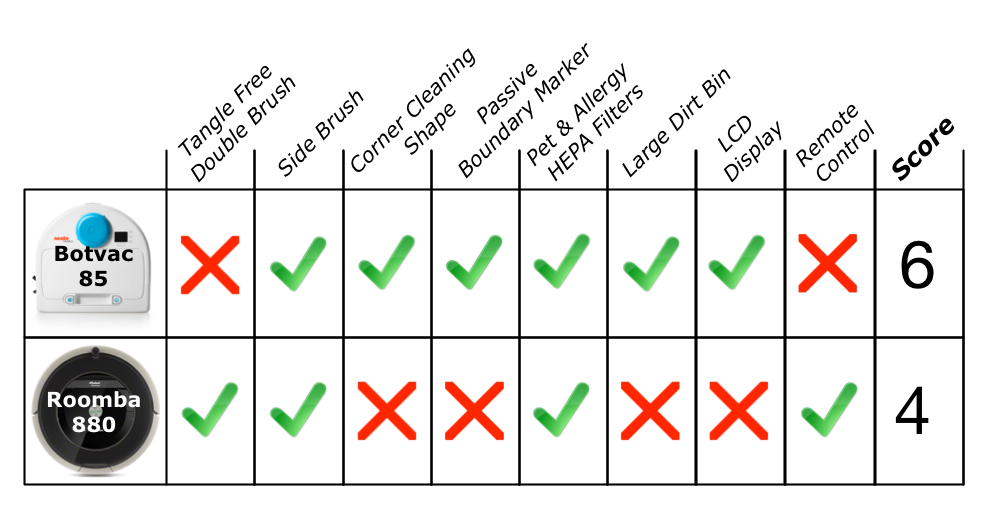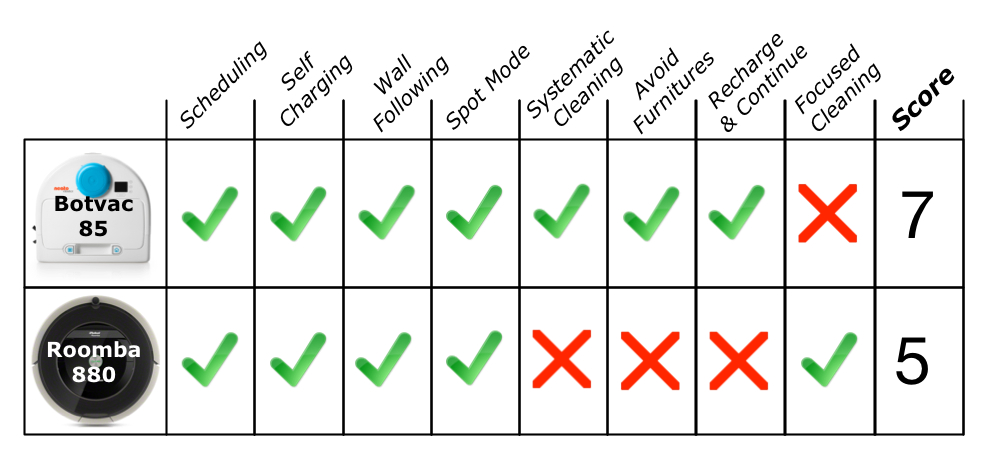Neato Botvac 85 vs. Roomba 880

Update: Checkout our review of BotVac Connected the latest robotic vacuum from Neato Robotics and how it compares to the Roomba 980 by iRobot.
Neato revealed no less than four new robotic vacuums: the Botvac series. Sounds cool. But, let’s see how they actually compare to the market leader: Roomba. In this review, we compare the high end Botvac 85 with its rival from iRobot the Roomba 880. First, we start by presenting each one of the competitors. Then, we proceed with a detailed comparison based on two complementary analysis. On the one hand we compare the hardware of the robotic vacuums. Then, we evaluate their behaviors which is the tip of the software iceberg. Our reviews are based on a series of objective criteria that eventually lead to a recommendation.
- Neato Botvac 85
- iRobot Roomba 880
- Hardware Comparison
- Software Comparison
- Conclusion & Recommendation
Neato Botvac 85
A unique characteristic of all Neato vacuums is that they embed a laser (see Video 1). It makes a huge difference in cleaning behavior as compared to all other vacuums. Competitors including the Roomba randomly bounce around. They do statistical cleaning, meaning that they are not 100% sure to cover a room, although in practice they are nearly there. The Neato has a more systematic approach. It scans the room to build a map of the area to clean. Based on the map, it moves around in a way that is closer to what a human actually do with a traditional vacuum. The laser has a secondary interesting consequence. The vacuum avoids furnitures without bumping into them.
Now let’s get a closer look to the Botvac series. These new Neato robotic vacuums outperform all older Neato series including the Neato XV Signature and Signature Pro. The shape remains the same, since it has proven its efficiency for cleaning corners. But, the BotVacs are better in cleaning room edges with a wider main brush complemented with a new side-brush. The dust bin has also evolved and became larger. Another notable change is at the usability level which has been enhanced. The user interface level has been polished, and there is now an extra button for launching the spot cleaning program.
With the Botvac series, Neato had the great idea to distinguish them with different colors for the laser lid. The Botvac 85 is the one with a blue lid. This luxury version of the Botvac series is also the most expensive one, costing approximatively $600. It comes with 3 high performance filters that capture small dust particles and allergens. The box also includes a boundary marker, a plain blade brush and a combo brush which is the most efficient one for cleaning carpets.
Video 1: Neato BotVac Series
iRobot Roomba 880
There are plenty of Roomba series and models, with different features and enhancements compared to the original. But, the latest Roomba 880 introduced what can be viewed as a true revolution. According to iRobot, its dual counter-rotating dirt extractors (see Videos 2 and 3) require virtually no maintenance. No more entangled debris that require frequent dismounting and cleaning. A bonus feature is that extractors are supposed to break down dirt into smaller parts easier to suck.
Another interesting feature of the Roomba 880 is a combination of an optical and an acoustic sensors for dirt perception. They ensure a better detection of dirtier areas and trigger the persistent cleaning behavior at the right spot. The first version of this focused cleaning function has been introduced on early versions Roomba, based on the acoustic sensor alone. Recently, it has been improved on some models of the 700 series with the addition of the optical sensor. It is this second version that is shipped on the 880.
Regarding the price, the Roomba 880 is expensive, costing approximatively $650. A cheaper alternative is to buy a Roomba from older series starting from $300. This obviously means that you won’t get all the nice features of the 880.
Video 2: Roomba 800 Series
Video 3: Roomba AeroForce Cleaning System
Hardware Comparison
Table 1 gathers the results of our hardware comparison showing that the Botvac is the better one, although from the maintenance point of view, the Roomba wins thanks to its unique tangle free brush. But, when it comes to cleaning the edges, the BotVac is superior. Beside the side brush that is also available on the Roomba, the BotVac has a square-shaped front which is more suitable for reaching corners.
Both robotic vacuums are shipped with boundary markers to restrict cleaned areas. The difference here lies in the need for batteries. The Botvac’s boundary marker is passive requiring no battery to operate. This results into less waste, making the Botvac more eco-friendly than the Roomba.
For Pet owners and sensitive people, both vacuums have HEPA filters. Compared to basic filters, HEPA filters are able to capture finer particles as compared to standard filters. As a result the dirt bin is filled faster. Speaking of the dirt bin, the Botvac’s one is significantly larger (0.7L) than the Roomba’s one (0.416L). The bigger is obviously the better since you have to empty and clean it less often.
Last, from the user interface point of view there’s a tie. The Botvac has an LCD which is more convenient for setting up the robot and scheduling its operations. The Roomba has only a set of multi-function buttons. But, it comes with a remote control that allows controlling the robot without directly handling it.
Table 1: Hardware Comparison
Software Comparison
As with the hardware, the Botvac proves to be superior to the Roomba regarding the software (see Table 2). Both robots share four basic features:
- Scheduling: You can set up your vacuum to operate when it’s most convenient, typically when you’re out.
- Self Charging: Once the cleaning is over, the robot goes back to its docking station for recharge.
- Wall following: The robot follows walls to clean dirt that accumulates on room edges.
- Spot mode: Makes the robot clean only a small area. This is typically useful if you spilled something.
But, the Botvac behavior benefits from the embedded laser as shown by the next three criteria. Since it builds a map of the room, the Botvac computes a path ensuring a methodical cleaning, while avoiding furnitures. A nice consequence of this natural cleaning is that you can see the vacuum progress.
On the contrary, with the Roomba, its hard to distinguish dirty areas from clean ones until it’s almost done. This is because it moves randomly bouncing from one obstacle to the other. It can pass nearby some dirty spot and ignore it until much later. However, in case its sensors detect a location with a lot of dirt, the 880 switches to persistent cleaning mode. This mode consists in spending some time going back and forth on the dirty area.
The Botvac does not have such focused cleaning mode, though this is somehow counterbalanced with systematic cleaning. A dirty spot nearby the robot will not be ignored too long. Besides, the Botvac is more effective for cleaning large areas. In case it runs out of battery, the robotic vacuum will go back to its dock. Once recharged, it will resume cleaning at the same position where it did stop.
Table 2: Software Comparison



10 Comments
Thanks for your excellent write-up.
This was the most useful line for my decision between the 80 and 85:
“It has the exact same characteristics as the Botvac 85, except that it is shipped with no extra filters”
So, at the end of the article you state that the 80 and 85 are exactly the same except the 80 doesn’t come with an extra filter. Are you telling your readers then that the filters cost $100? Seriously?
The difference between BotVac 80 and 85 is the number of filters in the box. You have only one with the BotVac 80 and 3 filters with 85. Checkout the specs . The prices evolves however. Now the BotVac 85 costs only $50 more.
Just purchased botvac 85 received it today. It is running now seems to be doing a good job.
I have had both, I returned the Roomba it’s like a drunk sailor roaming aimlessly bumping into everything. The Botvac is Smart edges the room and cleans in straight lines not missing a square inch, with out hitting anything! I ran the Botvac after the Roomba and the Botvac pick up a lot of stuff the Roomba, not the case when you reverse the experiment. For me the Botvac is less money for a better performer. Yes the botvac has to charge for 3 hours if you have a big house but, if your programing it, does it matter? No because it’ll be done by the time you get home. While cleaning every room without the need for addition hardware like the roomba requires to do the same thing.
Does anyone have any experience in how the Roomba 880 and Neato 85 handles pet hair? Does Neato blow them around the room?
Yes, Neato blow hair and dust away a bit sometimes but not so much. I’m happy with Neato anyway.
Neato does pet hair 1000 times better then roomba, but then has a problem w ball bearings.
Neato is better in every way, except customer service. :(